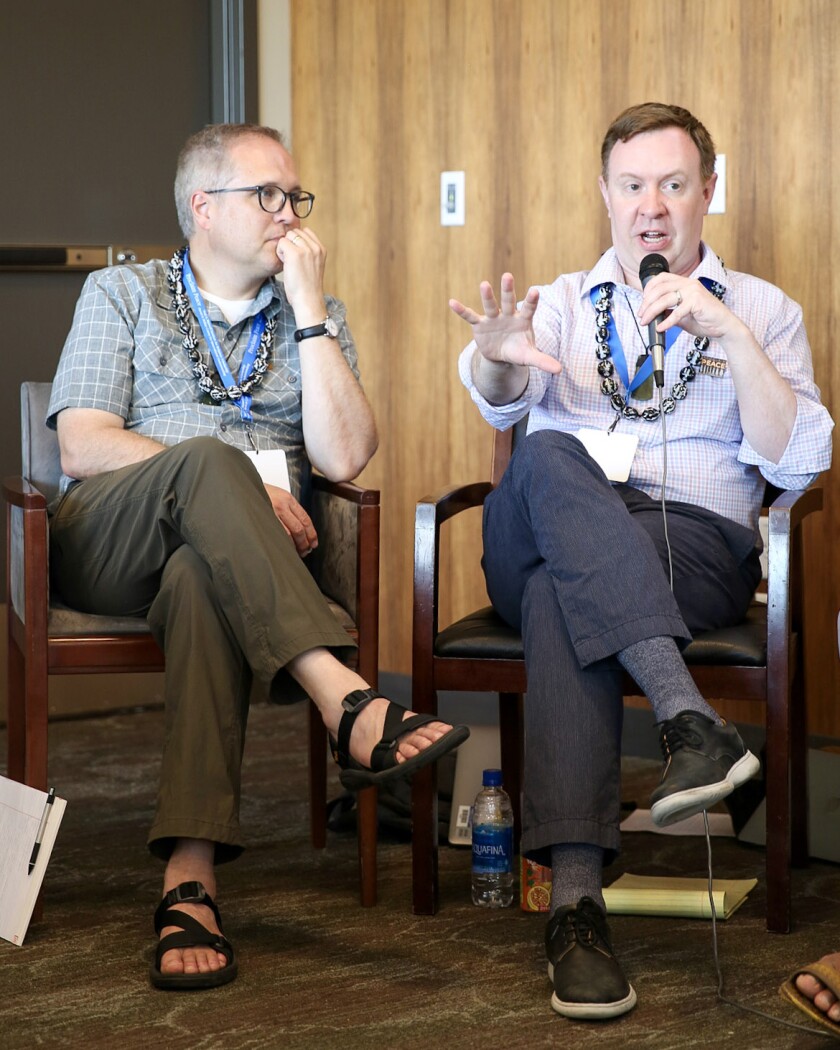
In 2011, academics and authors David Pulsipher and Patrick Mason both attended an academic conference on the subject of the Mormon perspective on war and peace. Pulsipher said it was when they went out to get yogurt that he proposed writing a book about how the restored gospel supports peace efforts. The finished work “Proclaim Peace: The Restoration’s Answer to an Age of Conflict” was the centerpiece of the Proclaim Peace Academic Conference held at BYU–Hawaii’s campus and sponsored by the Maxwell Institute for Religious Scholarship.
Problems that hinder peace
Mason, a historian and the Leonard J. Arrington Chair of Mormon History and Culture at Utah State University, said a recurring critique of the book written with Pulsipher is that it is “aspirational theology,” or the ideals of believing in peace sound nice but are not realistic.
Mason said, “This may be true in our feeble application, but it is not true in what the scriptures teach and tell us to do.” He continued, “Violence may be justifiable in rare circumstances, but only non-violence responses based in love are truly sanctifying and efficacious in the long term.”
“What fascinated me about non-violence,” said Pulsipher, “is how well it fit with the gospel of Jesus Christ.”
Pulsipher said even though peace is an integral part of the gospel of Jesus Christ, some members don’t believe or practice peace. “There’s a lot of historical reasons,” explained Pulsipher. “It is associated with hippie, anti-establishment people. We don’t embrace peace for the same reason we don’t embrace beards on BYU campuses,” he said with a laugh.
Mason said another explanation for not practicing peace is “We have been taught by the media that violence is the strongest and most effective force and that love might be morally ideal but is weak and ineffective. But according to our theology and modern research, love is stronger and more effective.”

Restoring the peace
In one of the conference sessions, Mason asked what a society would look like that taught peace as much as today’s society teaches violence.
“If we want a culture of peace, we have to build it brick by brick. That’s a whole lot of undoing the work of Hollywood movies, video games, and Sunday school lessons,” said Mason.
God instructs his children to be anxiously engaged in a good cause and do things of their own free will, Mason said. God doesn’t tell people exactly what to do, he added, and that challenge is up to them and their creativity.
Mason said someone who had served in the military published a critical review of their book. He said because of this critic's experience, they had a very different ideological approach than himself and Pulsipher.
The critic said in his review, the Latter-day Saint peacebuilding community has treated him with disdain and called him a warmonger. Mason said it was clear to him this critic has been wounded repeatedly by people who call themselves peacebuilders. Mason said this broke his heart. “Are we approaching relationships with people who we disagree with the principles we believe in?” he asked the assembled people at the peace conference.
10 years to complete the book
After a decade of work, the authors said their book was published. “We kept getting sidetracked with other projects,” Pulsipher explained, “but I think the book is better for it. It needed to develop with time.”
The Proclaim Peace conference was held eight months after the book came out.
“BYU–Hawaii was such a perfect place to host this conference because of the intercultural peacebuilding program but also because of the incredible diversity of the student body,” said Mason. “It’s not an accident that President McKay placed peacebuilding as the heart of the mission of the institution.”
To read the story about the conference, click here.
To read about BYU-Hawaii alumni who talked about their experiences building peace around the world, click here.
